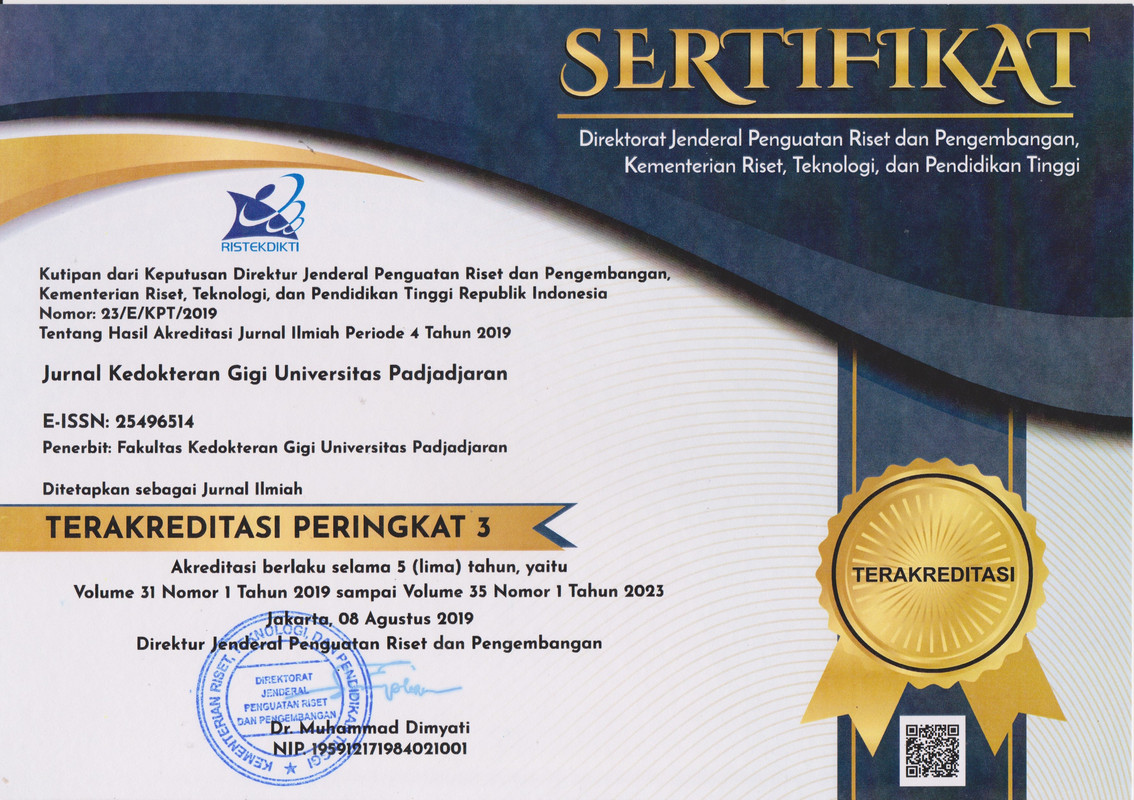Perawatan ulang saluran akar gigi molar dua kiri rahang bawah akibat adanya missed canal: laporan kasus
Abstract
ABSTRAK
Pendahuluan: Keberhasilan endodontik diperoleh dengan persiapan akses yang baik, mendapatkan setiap saluran akar sesuai anatomi, pembentukan saluran akar, desinfeksi dan pengisian sistem saluran akar. Lokalisasi saluran akar diperlukan untuk desinfeksi dan obturasi saluran yang tepat. Perawatan endodontik, saluran akar yang tidak dirawat dapat berfungsi untuk menampung reservoir mikroorganisme sehingga menjadi penyebab umum dari infeksi intra radikular persisten dan periodontitis apikal pasca perawatan. Tujuan dari laporan kasus ini yaitu untuk menjelaskan penatalaksanaan missed canals Molar dua kiri rahang bawah. Laporan kasus: Perempuan usia 25 tahun datang ke RSGMP dengan keluhan gigi belakang kiri bawah tambalan lepas sejak 1 tahun yang lalu, merasa tidak nyaman saat mengunyah atau menggigit sejak 1 bulan yang lalu. Pemeriksaan objektif tidak terdapat restorasi koronal, perkusi positif, palpasi negatif, mobilitas normal. Gambaran radiolografi menunjukkan radiolusensi periapikal, tampak saluran akar mesial yang tidak dirawat dan saluran distal yang kurang hermetis. Diagnosis berdasarkan pemeriksaan subjektif, objektif dan radiografi gigi 37 yaitu previously treated teeth. Prevalensi missed canals paling tinggi pada molar pertama rahang atas dan pada rahang bawah yaitu molar kedua. Gigi molar kedua rahang bawah missed canals paling sering ditemukan di akar mesial umumnya disertai lesi periapikal. Laporan kasus ini, ditemukan missed canals dengan radiolusensi periapikal serta tidak adanya restorasi koronal. Metode perawatan yaitu dengan perawatan ulang saluran akar non bedah. Simpulan: Perawatan ulang saluran akar akibat adanya missed canal didapatkan hasil yang optimal jika didukung dengan keterampilan operator, bantuan alat, dan kerjasama yang baik dengan pasien
Kata kunci: Perawatan saluran akar, missed canal, periapical lesion
Root canal retreatment of the lower left second molar due to a missing canal: a case report
ABSTRACT
Introduction: Endodontic success is achieved by good access preparation, obtaining each root canal according to anatomy, root canal shaping, disinfection, and filling of the root canal system. Localization of the root canal is necessary for proper disinfection and obturation of the canal. In endodontic treatment, untreated root canals can serve to harbor a reservoir of microorganisms, thereby causing a common cause of persistent intraradicular infection and post-treatment apical periodontitis. The aim of this case report is to describe the root canal management of a missed mandibular second molar. Case report: A 25-year-old woman came to RSGMP with complaints of a loose filling in her lower left back tooth since 1 year ago and feeling uncomfortable when biting or biting since 1 month ago. The aim of the examination is to determine if there is no coronal recovery, positive percussion, negative palpation, or normal mobility. Radiographic images showed periapical radiolucency, untreated mesial root canals, and fewer hermetic distal canals. The diagnosis is based on a subjective, objective, and radiographic examination of 37 teeth, namely those that have been treated previously. The prevalence of missed root canals is highest in the maxillary first molars and in the mandibular second molars. Missing canals of mandibular second molar teeth are most often found in the mesial roots, generally accompanied by periapical lesions. In this case report, a missed tract was found with periapical radiolucency and no coronal recovery. The treatment method is non-surgical root canal re-treatment. Conclusion: Root canal re-treatment due to missed canals obtains optimal results if supported by operator skills, equipment assistance, and good cooperation with the patient.
keyword:perawatan saluran akar, missed canal, periapical lesion
Keywords
Full Text:
PDFReferences
DAFTAR PUSTAKA
Machtou Pierre, Ruddle JC. Endodontic Orthograde Retreatment and Management of Mishaps. In Rostein Ilan, Ingle IJ, editor. Ingle’s endodontics 7st Ed. North Carolina: Pmph usa; 2019. p. 748
Pessotti VP, Jiménez-Rojas LF, Alves FRF, Rôças IN, Siqueira JF Jr. Post-treatment apical periodontitis associated with a missed root canal in a maxillary lateral incisor with two roots: A case report. Aust Endod J. 2022 Jul 8. DOI: 10.1111/aej.12657.
Siquera FJ, Rocas NI. Treatment of endodontic infections 2nd Ed. Germany: Quintessenz Verlags-GmbH Berlin; 2022. p. 426
Baruwa AO, Martins JNR, Meirinhos J, Pereira B, Gouveia J, Quaresma SA, Monroe A, Ginjeira A. The influence of missed canals on the prevalence of periapical lesions in endodontically treated teeth: a cross-sectional study. J Endod. 2020 Jan;46(1):34-39.e1. DOI: 10.1016/j.joen.2019.10.007.
Mashyakhy M, Hadi FA, Alhazmi HA, Alfaifi RA, Alabsi FS, Bajawi H, et al. Prevalence of missed canals and their association with apical periodontitis in posterior endodontically treated teeth: A CBCT Study. Int J Dent. 2021 Jun 28;2021:9962429. DOI: 10.1155/2021/9962429.
Terauchi Y, Parirokh M, Handysides R. Nonsurgical Retreatment. In Endodontics principles and practices 6rd ed. Elsevier; 2021. p. 407-10.
Do Carmo WD, Verner FS, Aguiar LM, Visconti MA, Ferreira MD, Lacerda M, et al. Missed canals in endodontically treated maxillary molars of a Brazilian subpopulation: prevalence and association with periapical lesion using cone-beam computed tomography. Clin Oral Investig 25:2317-2323. DOI: 10.1007/s00784-020-03554-4
Machado R, Pereira JA, Vitali FC, Bolan M, Rivero ERC. Persistent pain after successful endodontic treatment in a patient with Wegener's granulomatosis: a case report. Restor Dent Endod. 2022 Jun 9;47(3):e26. DOI: 10.5395/rde.2022.47.e26.
Zuolo LM, Kherlakian D, Mello JDE, Maria Inês Ranazzi Cabral Fagundes MIC, Carvalho MCCD. Reintervention in Endodontics. Quintessence Publishing. 2014. p. 52.
Mustafa M, Almuhaiza M, Alamri HM, Abdulwahed A, Alghomlas ZI, Alothman TA, et al. Evaluation of the causes of failure of root canal treatment among patients in the City of Al-Kharj, Saudi Arabia. Niger J Clin Pract. 2021;24(4):621–8. DOI: 10.4103/njcp.njcp_290_20
Plotino Gianluca. Minimally Invasive Approaches in Endodontic Practice. Springer Nature Switzerland AG. 2021. p. 1-2.
Dioguardi M, Stellacci C, La Femina L, Spirito F, Sovereto D, Laneve E, et al. Comparison of endodontic failures between nonsurgical retreatment and endodontic surgery: systematic review and meta-analysis with trial sequential analysis. Medicina (Kaunas). 2022 July 4;58(7):894. DOI: 10.3390/medicina58070894.
Hikmah Noor, Kosi Rina. Endodontic reintervention of the maxillary first premolar: a case report: J Case Rep Dent Med January 2021;3:1:22-25.DOI: 10.20956/jcrdm.v3i1.145
Costa F, Pacheco-Yanes J, Siqueira JF, Jr. Oliveira ACS, Gazzaneo I, Amorim CA, et al. Association between missed canals and apical periodontitis. Int Endod J 2019;52:400-6. DOI: 10.1111/iej.13022
Deus DG, Emmanuel JNL, Souza ES, Zuolo MV, Shopping for cleaning the root canals a clinical- based strategy. Springer Nature Switzerland AG. 2022. p. 134-5.
Dietschi D, Boillaguet S, Sadan A, Restoration of the Endodontically Treated Tooth. In Hargreaves MK, Berman HL. Cohen's Pathways of the Pulp 12rd ed. Elsevier. 2016. p. 822-3.
Zie ̨bowicz A, Oßwald B, Kern F, Schwan W. Effect of simulated mastication on structural stability of prosthetic zirconia material after thermocycling aging. Materials 2023,16,1171. DOI: 10.3390/ma16031171
Felberg RV, Bassani R, Pereira GKR, Bacchi A, Silva-Sousa YTC, Gomes EA, et al. Restorative possibilities using zirconia ceramics for single crowns. Braz Dent J. 2019 Oct 7;30(5):446-452. DOI: 10.1590/0103-6440201902780.
Martins JNR, Marques D, Silva L, Jo E. Prevalence studies on root canal anatomy using cone-beam computed tomographic imaging: a systematic review. J Endod. 2019;45(4):372–386. DOI: 10.1016/j.joen.2018.12.016.
Pan JYY, Parolia A, Chuah SR, Bhatia S, Mutalik S, Pau A. Root canal morphology of permanent teeth in a Malaysian subpopulation using cone-beam computed tomography. BMC Oral Health. 2019;19(1):14. DOI: 10.1186/s12903-019-0710-z.
DOI: https://doi.org/10.24198/jkg.v36i4.46893
Refbacks
- There are currently no refbacks.
Copyright (c) 2024 Jurnal Kedokteran Gigi Universitas Padjadjaran
INDEXING & PARTNERSHIP

Jurnal Kedokteran Gigi Universitas Padjadjaran dilisensikan di bawah Creative Commons Attribution 4.0 International License






.png)

















